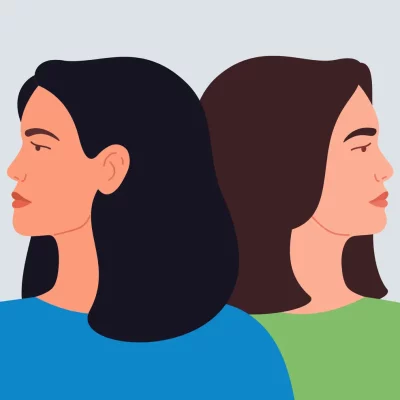Mood disorders, such as Premenstrual Dysphoric Disorder (PMDD) and Premenstrual Syndrome (PMS), can significantly impact a person’s mental health. These disorders are often misunderstood and can be mistaken for each other due to their similar names and symptoms.
PMDD and PMS are two distinct disorders that require different approaches for effective symptom management. In this article, we will discuss the differences between PMDD vs PMS, their symptoms, potential causes, coping skills for intense symptoms, and available symptom management options for your mental health.
Note: Both PMDD and PMS can manifest in multiple physical symptoms and physical causes (such as hormonal changes). This article will focus only on the mental health symptoms associated with both disorders. Discuss the physical symptoms you are experiencing with your counselor or doctor for more guidance on physical symptoms or pain management.
Understanding PMDD
PMDD is a severe form of Premenstrual Syndrome (PMS) that affects approximately 1 in 12 women during their reproductive years. It is a chronic disorder that manifests as physical and emotional symptoms in the days leading up to menstruation and lasts until the start of the menstrual cycle. PMDD is recognized as a mental health condition by the Diagnostic and Statistical Manual of Mental Disorders (DSM-5) and can significantly impair your daily functioning.
Symptoms of PMDD include:
-
- Severe mood swings
-
- Irritability and anger
-
- Depression and anxiety
-
- Difficulty concentrating
-
- Fatigue
-
- Insomnia or hypersomnia
It is essential to note that these symptoms must be present for at least two consecutive menstrual cycles to diagnose PMDD.
Causes of PMDD
The exact cause of PMDD is unknown. There are many potential causes for this condition. Some possible factors that may contribute to the development of PMDD include genetics, stress, and a history of trauma or abuse.
Understanding PMS
PMS is a common condition that affects 3 out of 4 women during reproductive years. It refers to a wide range of physical and emotional symptoms that occur in the days leading up to menstruation and resolve with the start of your menstrual cycle. PMS is not recognized as a mental health disorder. Still, PMS can significantly impact your daily life while experiencing symptoms.
Symptoms of PMS include:
-
- Mood swings
-
- Irritability
-
- Anxiety or nervousness
-
- Tension and irritability
-
- Fatigue
Similar to PMDD, these symptoms must be present for at least two consecutive menstrual cycles to diagnose PMS.
Potential Causes of PMS
The exact cause of PMS is also unknown. The severity of symptoms in PMS may depend on your sensitivity to the internal changes occurring during your cycle. A consistent, high stress level may also contribute to the onset or severity of PMS symptoms. Consulting a gynecologist may be necessary if you have significant physical symptoms.
The Differences between PMDD vs PMS
PMDD and PMS have some overlapping symptoms, as well as several critical differences between the two disorders. These differences include:
-
- Severity of symptoms: PMDD is characterized by more severe and debilitating symptoms than PMS.
-
- Duration of symptoms: PMDD symptoms start 10-14 days before menstruation and last up to two days after the onset of menstruation. PMS symptoms typically begin five days before and last up to four days after onset.
-
- Impact on daily functioning: The intense physical and emotional symptoms associated with PMDD can significantly impair your daily functioning. PMS may only cause mild discomfort during symptoms.
Coping Skills for Intense Symptoms
Managing the intense symptoms of PMDD and the mild symptoms of PMS can be challenging. Whether you experience severe or mild symptoms, there are various coping skills that you can use to alleviate your symptoms.
Coping strategies for PMDD and PMS symptoms include:
-
- Practice relaxation techniques such as deep breathing and meditation to reduce stress and tightness in your body can make your mental health symptoms worse.
-
- Get enough sleep and maintain a regular sleep schedule.
-
- Engage in a self-care routine that includes activities that you enjoy.
-
- Talk to a therapist or join a support group to receive a diagnosis for PMDD and increase your coping skills when you are symptomatic.
Symptom Management Options
If you are experiencing symptoms of PMDD or PMS that significantly impact your daily life, it is essential to seek professional help. A healthcare provider can diagnose your condition and provide you with appropriate treatment options, such as:
-
- Cognitive-behavioral therapy (CBT) to help manage symptoms and develop healthy coping strategies
-
- Medications such as antidepressants or birth control pills to regulate hormonal fluctuations
-
- Lifestyle changes, such as meditation and sleep hygiene, may improve your mental health both during and after experiencing symptoms.
Conclusion
PMDD and PMS are two distinct mood disorders that can significantly impact your mental health. While they share some similarities, PMDD is a more severe and debilitating condition than PMS, with a potential symptomatic range of up to 16 days out of the month. Understanding the differences between PMDD vs PMS is crucial in seeking appropriate treatment and managing symptoms effectively.
There are several symptom management options if your symptoms affect your daily life. Using CBT, certain medications, and specific lifestyle changes like adding a meditation routine to your day can significantly improve your symptoms over time. Your counselor can develop a symptom management plan tailored to your unique symptoms to help minimize the impact of these conditions on your life.
If you are ready to learn how to cope with your PMDD or PMS symptoms, call us at (833)-274-heal or schedule an appointment with a counselor who understands your frustration and challenges. Once you have your first appointment, you can discuss your symptoms, possible diagnosis, and coping skills you can use on day 1 to help reduce the effect of your symptoms. You don’t need to suffer alone.
Your 7-Step Self-Care Guide To Creating A Helpful Practice That Works For You
How To Meditate For Anxiety: Discover The Top 4 Meditation Techniques To Help You Find Peace








